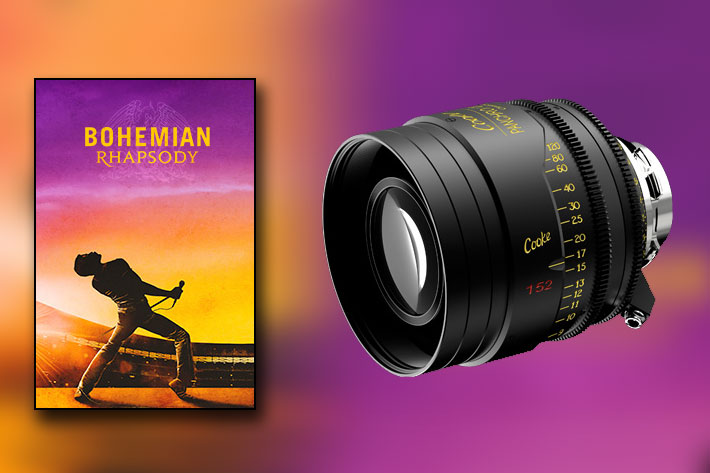
To capture the idealistic energy of Freddie Mercury and his future bandmates, Tom Sigel, ASC, used mostly a 40mm lens, with a special LUT for the Alexa SXT, to achieve the nostalgic look of the 70s.
Despite the mixed reviews, the inaccuracies of the story and time line, Bohemian Rhapsody, the film, can claim, at the end of the day “We are the champions!”. At the 76th Golden Globe Awards, the film received numerous accolades, winning Best Motion Picture – Drama and Best Actor – Drama, for Rami Malek for his portrayal of Freddie Mercury.
https://youtu.be/27zlBpzdOZg
A series of other nominations for both the motion picture and Rami Malek suggest that the film, released last November in the United States, will not only receive multiple awards but will confirm its blockbuster category, against the opinion from some critics. The film, whose production budget was about 50 million dollars, is already a massive box office success, grossing close to 800 million dollars worldwide, and the recent awards and nominations will, no doubt, contribute to make it even more popular. At the moment, Bohemian Rhapsody is the eighth-highest-grossing film of 2018 worldwide and the highest-grossing musical biographical film of all time.
The Arriflex 35BL and a memorable moment
That’s only part of the story, though, and while interesting, it does not reveal the whole picture. Let me add some more information to the story, as I believe it will be an element some of ProVideo Coalition readers will want to introduce into their conversation, when talking about Bohemian Rhapsody. There is even a another note of nostalgia about the whole production of the film: the camera used to shoot ‘I Want To Break Free’, using 16 and 35mm film, was an Arriflex 35BL, “the exact same camera that photographed Freddie’s very last video, just before he passed away.”
https://youtu.be/FB-AlABu-pw
Tom Sigel, ASC mentioned the fact, referring to it as one of the “more memorable moments of shooting Bohemian Rhapsody” while explaining why he chose Vintage Cooke Speed Panchros for shooting the early years of Freddie Mercury and Queen. He decided to combine original glass with a special LUT to express the look of the period.
A 40mm Cooke lens for most of the first act
Sigel needed to capture the idealistic energy of Freddie Mercury and his future bandmates when he first came to London in 1970. To accomplish this, he made use of a full vintage set of Cooke Speed Panchros, with a very light net at the back of the lens and a special LUT for the Alexa SXT that was specifically designed for the period. This set-up was used for the entire first act of the film, with Sigel relying mostly on the 40mm lens, with the 25, 32 and 50 as secondary lenses.
https://youtu.be/deqzls8N4yA
“It is very golden and romantic, but also a little raw — hand-held and grainy,” explains Sigel. “I had used the Cooke Speed Panchros in the past — when they weren’t so vintage! — and was always fond of the look. We did tests with a number of lenses and camera systems to find the right recipe for the film. While we looked at a few other lenses, we just kept coming back to the Speed Panchros. Combined with the Alexa SXT, the custom LUT and light netting, it spoke to me for the look of the period. I wanted something to reflect the early days of the 70s… a romantic/nostalgic kind of look.”
But Sigel would need to transition from those early days to a more modern look. To accomplish this transition, the film makes use of Queen’s fourth appearance on the BBC’s popular TV programme Top of the Pops in November 1974.
A passion for Cooke lenses
“Their appearance on Top of the Pops was a good way to make the transition,” said Sigel. “I used an ARRI ALEXA 65 mixed with Sony Betacam [introduced in 1982] to shoot the ‘Killer Queen’ set and while there weren’t a lot of cameras around, finding tape to record on was even more difficult. But this combination made the transition to Queen’s rise to fame less abrupt.”
“I have a long history with Cooke,” said Sigel. “Back in the 1980s, I went to the factory in Leicester and picked out a 9-50 zoom lens for my documentary camera. Whether vintage or new, the quality of Cooke lenses is a constant.”
Sigel’s passion for Cooke lenses is shared with many other filmmakers. While cinematographers can still find the vintage Cooke Speed Panchros lenses available for rent, complete with updated housings and mechanics, the interest for the lenses led Cooke to design a more modern version of the same lens, which some prefer. The company says that “the growing demand for vintage Cooke Speed Panchro lenses from the 1920s to 1960s prompted us to introduce a modern redesign of the vintage classic”, so they introduced the Cooke Panchro/i Classic, T2.2 to T3.2 Prime lenses.
The new Cooke Panchro is true to its origins
The new Panchro, adds Cooke, “that is true to the original look of the now legendary Speed Panchro, recreates the same look and feel of the original with the advantage of modern glass mounted for today’s cameras. And, the new lenses come equipped with /i Technology for frame by frame digital information capture, as do all modern Cooke cine lenses for film and digital capture.”
The original Cooke Speed Panchro, designed by Horace W. Lee in the 1920s, was a cine prime lens that chromatically enhanced an image when filming under restricted illumination. Cooke Speed Panchros combined a relative aperture as wide as f2.0 with an angular field of view and definition previously impossible with much smaller apertures. They quickly gained a worldwide reputation for quality cinema production and were widely used throughout the 20th century. The lens is available in the following focal lengths: 18, 21, 25, 27, 32, 40, 50, 65 MACRO, 75, 100, 135, 152mm.
